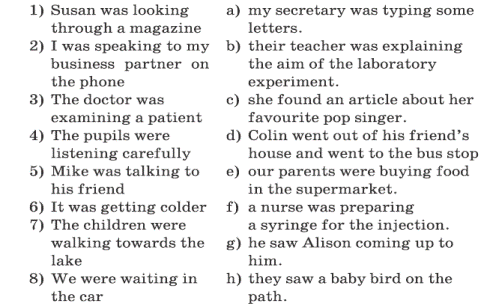Past Simple / Past Continuous
The Past Simple Tense of the most English verbs (regular verbs) is formed by adding "-ed"/"-d"; to their base form. (If the verb ends in "-e", we add "-d" to form the past simple.) There are also some verbs called irregular verbs that have special past tense forms. (See list of irregular verbs) We use the Past Simple Tense: · to describe actions and situations that happened in the past. These actions and situations were started and finished in the past. Example: Susan bought her little sister a doll. · The sentence often contains an adverb or adverb phrase of time, such as yesterday, the other day,last night, last week, three days ago, a few minutes ago, in (year), from (year) to (year), etc. Example: My brother lived in London for six years. · to talk about habitual or repeated actions that took place in the past Example: When she was young, she danced beautifully. · to tell a story and to express actions which follow each other in a story Example: It happened one night in the winter. · to refer to the historical past or to events that have happened in the distant past relative to the speaker Example: Romans built strong bridges. · for reporting what someone said (converting from direct to reported speech) Example: David said that he was tired. · to talk about action in the past that take place in the middle of another action Example: I was having a bath when the phone rang. · for making second conditional sentences (also called conditional type 2) when we talk about an imaginary or unlikely situation and to describe its result. (If + past simple, would + infinitive) Example: If I won the lottery, I would travel the world. The Past Continuous is made with the Past form of the verb "to be"; (I was, you were, he/she/it was, we were, you were, they were) + the '-ing' form of the main verb. The '-ing' form of the verb is called the Present Participle. We use the Past Continuous Tense: · to say that someone was at the middle of doing something at a certain time. The action or situation has already started before this time but hadn't finished yet: Example: What were they doing at 10 o'clock? They were working at the garden. · The Past Continuous is also used together with the Past Simple to say that somehing happens at the middle of something else: Example: David was reading a book in the park when suddenly it began to rain. · to indicate that two actions in the past were in the progress simultaneously (with while): Example: While I was studying in one room my older sister was having a party in the other room. · to express action that were in progress at the time of another particular time: · to talk about irritating repeated actions in the past (with always, constantly): · to make polite inquiries: Example: I was wondering if you could lend me your new car for a few hours.
Exercise 1.Put the verbs in brackets into the right form:
Exercise 2.Translate into English:
Exercise 3.Match two parts of the sentence and join them with when or while:
|







